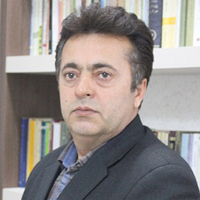Some Evidence on the Existence of Ellipi Castle Underneath the Falak-0 Al Aflak Castle, Khorram Abad, Iran
Author(s):
Abstract:
Khorramabad Valley is located in Central Zagros region although has its own unique features. In the middle of the valley، where the Khorramabad River turns northwest and creates an angle، there is a natural bedrock under which a watery spring gushes. The bedrock is surrounded by the river from east، south، and southwest. In August 2008، stratigraphic excavation was started by digging a 3×3m trench on the south-western corner of the second court in Falak-ol-Aflak Castle، which reduced to 2×1m and became 13. 30 m in depth finally. Following two season of excavation، five cultural periods were identified، which chronologically include the Late Iron Age II (8th – 9th century BC)، Trans-Achamenid، Parthian، Sassanid، and Late Islamic period. During the 2nd season of the stratigraphic excavations carried out at the precincts of Falak-ol-Aflak Castle in Khorramabad valley in 2008، some signs of a large brick wall were appeared. The wall started from a depth of 6. 30 meters from the brick floor of its second precinct، continuing up to the surface of the hill bedrock at a depth of 13. 30 meters. The evidences of pottery، so-called Genre of Luristan have been found from the oldest deposits of a known settlement of stratigraphic trench، which is backed to the 9th and 8th centuries B. C. The known triple layers of this period with the evidences of burnt at the upper parts are contemporary with a wide brick defensive wall which its surface is covered. The size of used bricks is resemble to the similar ones at Lorestan specially Babajan. The oldest settlement period of this site has not been identified from the stratigraphic trench، but an excavated trench doing the stability activities of castle foundation in the southern part of the second yard has shown that the thick layers is belong to the Middle and late Bronze Age with the potsherds parallel to the Godin III culture. These shards are also existence as the mixed materials of the mentioned bricks in the wide wall. It seems that، during the 9th and 8th centuries B. C the Bronze Age layer has been removed making a building foundation on the natural rocks. As well as، the deposits of this layer were used as construction materials of the given wall. This situation caused to unidentified layer of Bronze Age in the stratigraphic trench which situated inside above mentioned wall. According to the states and hypothesizes made by Iron Age experts، the Ellipi Rulership reigned to the Pishkouh-I Luristan during the first centuries of the 1st millennium B. C. This rulership was united with Elamite، while it was enemy with Assyria. The ancient documents of many Assyrian kings described their campaigns and cited many of the Ellipi places as well. The cultural data of this period are the architectural remains at Babajan and the pottery so-called “Genre of Luristan”. The architecture found out Babajan the Goffʼs excavations has been special traits. Based on reports and articles which showed these traits have been stone base which mud-brick walls formed on it and surface of these walls were clay plastered. Outside in front of these walls there were fixed towers، unlike other periods، instead gyrate towers with orthogonal towers saw in Babajan. These traits found out in Falak-ol-Aflak fortress excavations. This article tries to introduce the discovered brick structure as a part of a castle attributed to the Ellipi State rules during the 9th and 8th centuries B. C. We believe that this castle has been destroyed and burnt out during the ruinous attacks by one the Assyrian kings in the late 8th or early 7th centuries B. C.
Keywords:
Central Zagros , Khorramabad , Falak , ol , Aflak Fortress , Ellipi , Stratigraphy
Language:
Persian
Published:
Iranian Archaeological Research Journal, Volume:4 Issue: 7, 2015
Pages:
81 to 94
magiran.com/p1371276
دانلود و مطالعه متن این مقاله با یکی از روشهای زیر امکان پذیر است:
اشتراک شخصی
با عضویت و پرداخت آنلاین حق اشتراک یکساله به مبلغ 1,390,000ريال میتوانید 70 عنوان مطلب دانلود کنید!
اشتراک سازمانی
به کتابخانه دانشگاه یا محل کار خود پیشنهاد کنید تا اشتراک سازمانی این پایگاه را برای دسترسی نامحدود همه کاربران به متن مطالب تهیه نمایند!
توجه!
- حق عضویت دریافتی صرف حمایت از نشریات عضو و نگهداری، تکمیل و توسعه مگیران میشود.
- پرداخت حق اشتراک و دانلود مقالات اجازه بازنشر آن در سایر رسانههای چاپی و دیجیتال را به کاربر نمیدهد.
In order to view content subscription is required
Personal subscription
Subscribe magiran.com for 70 € euros via PayPal and download 70 articles during a year.
Organization subscription
Please contact us to subscribe your university or library for unlimited access!




